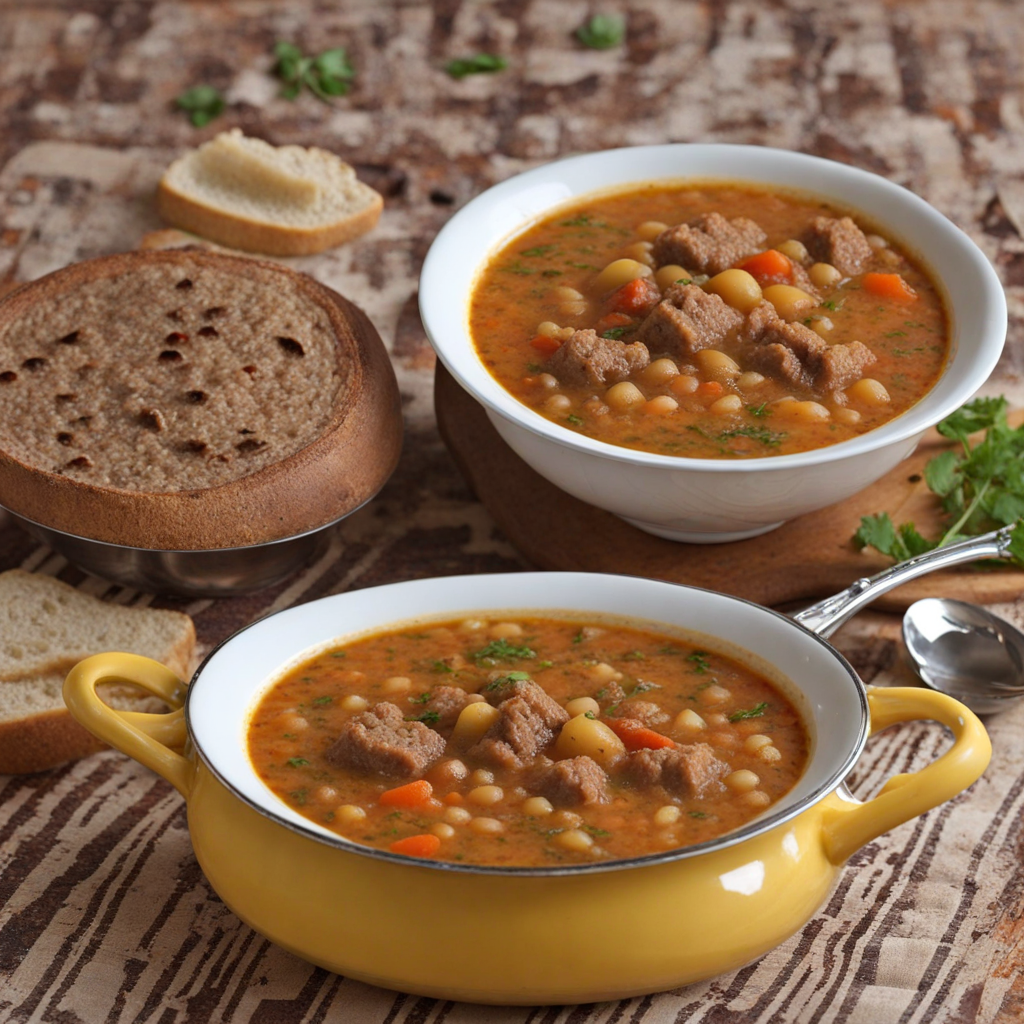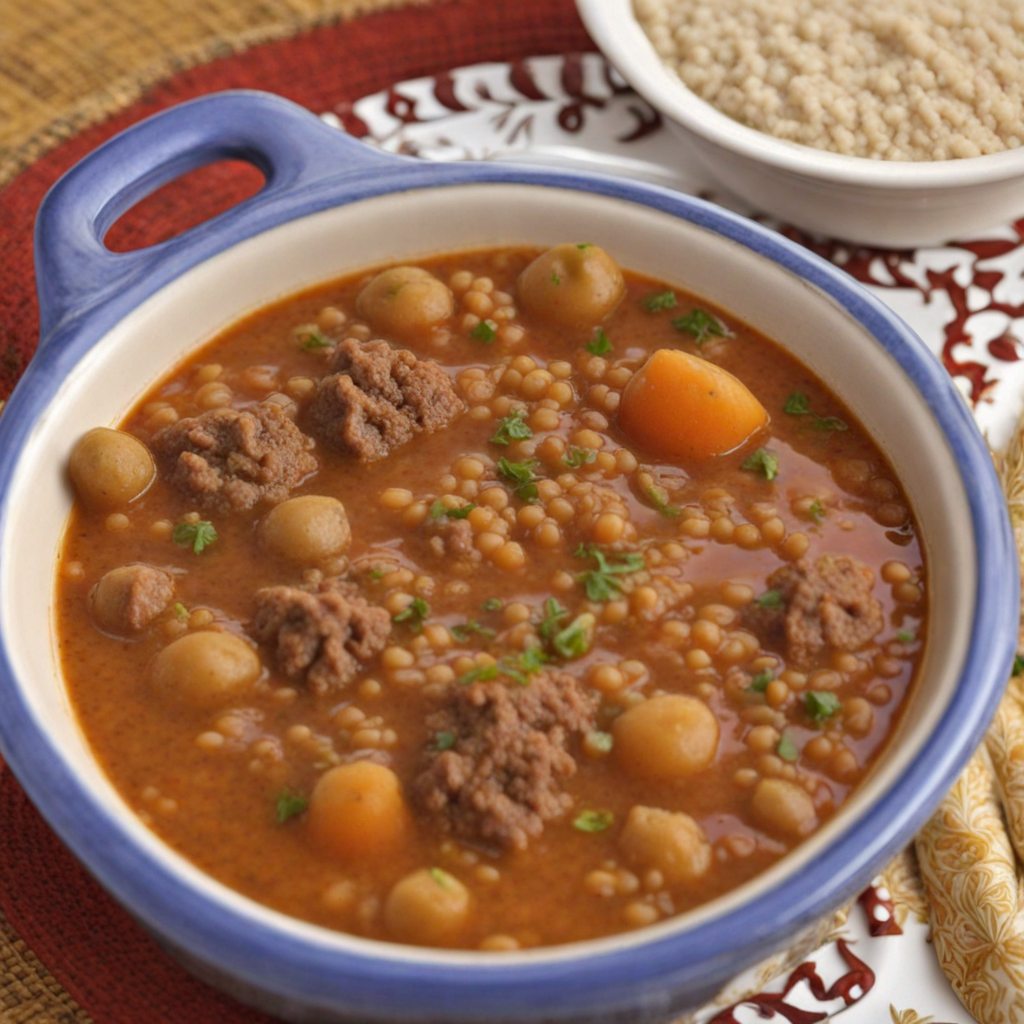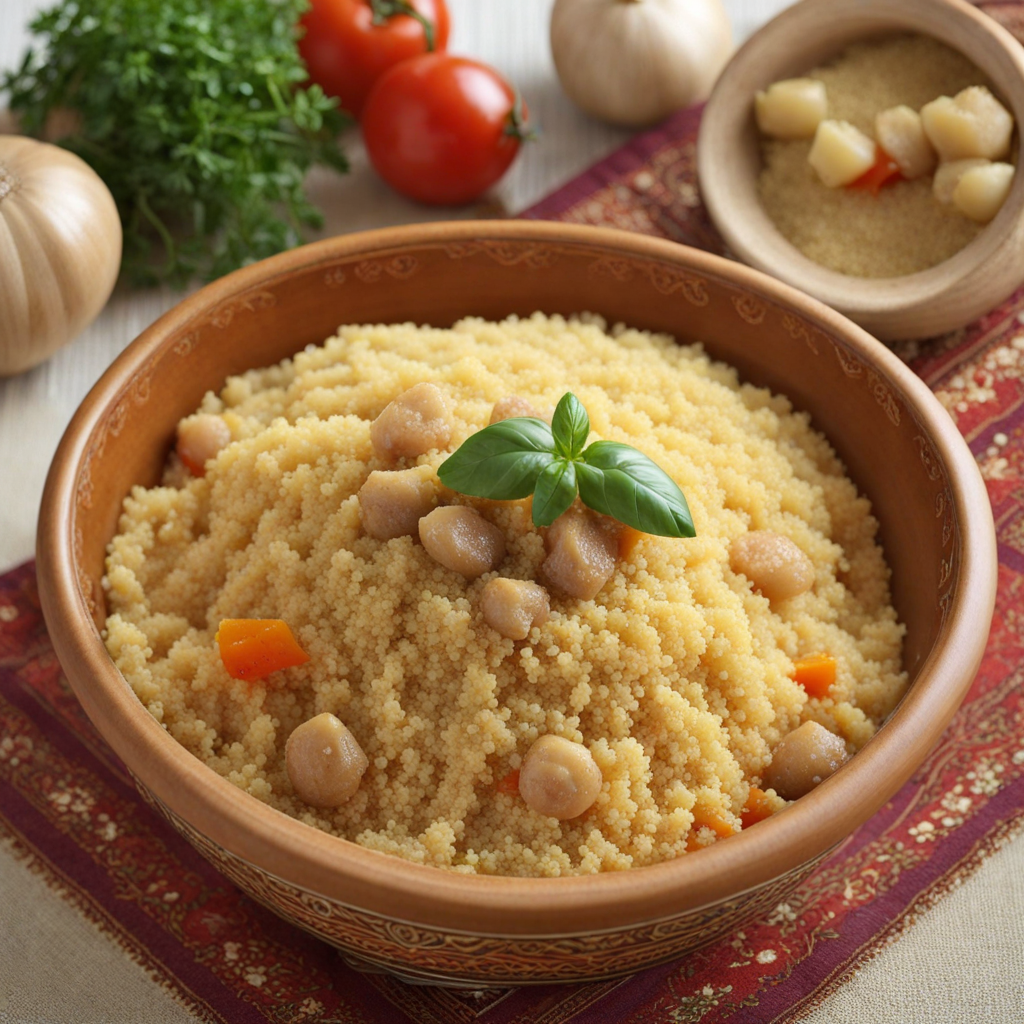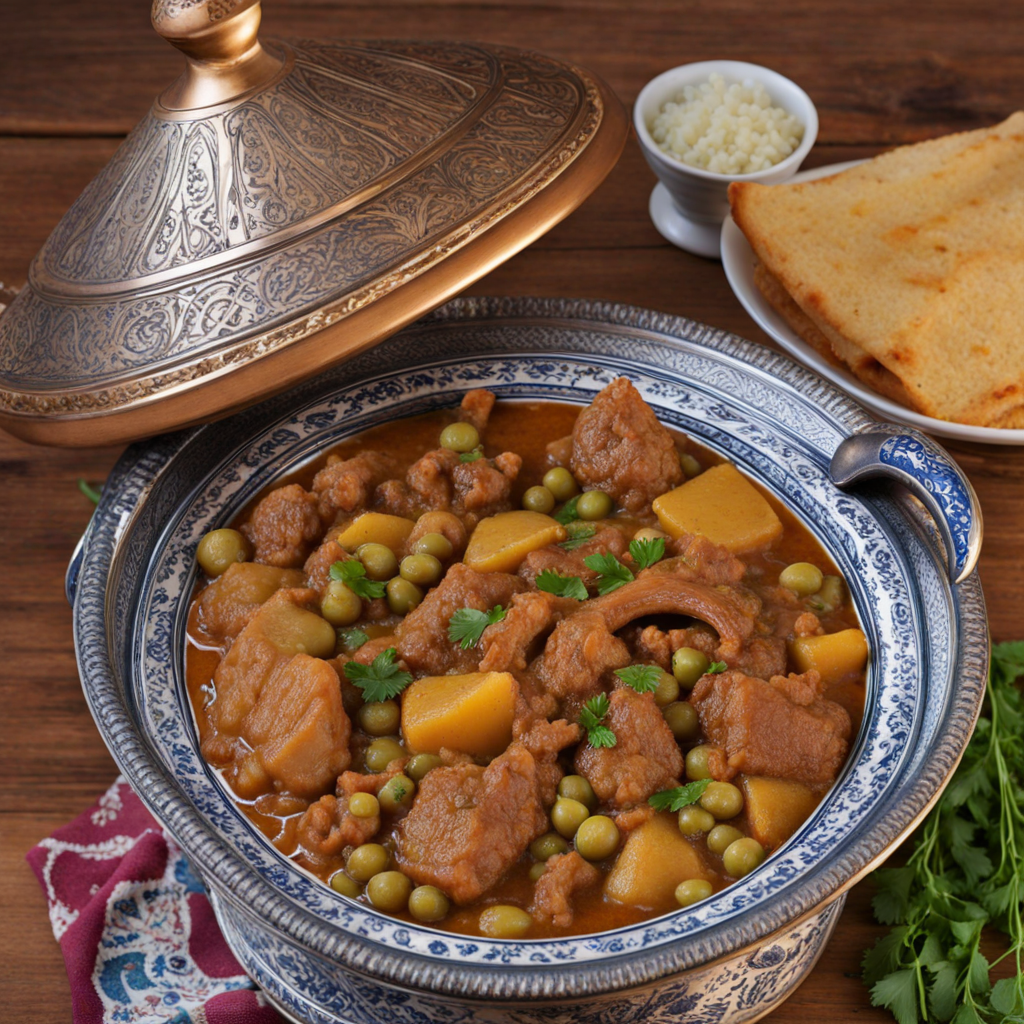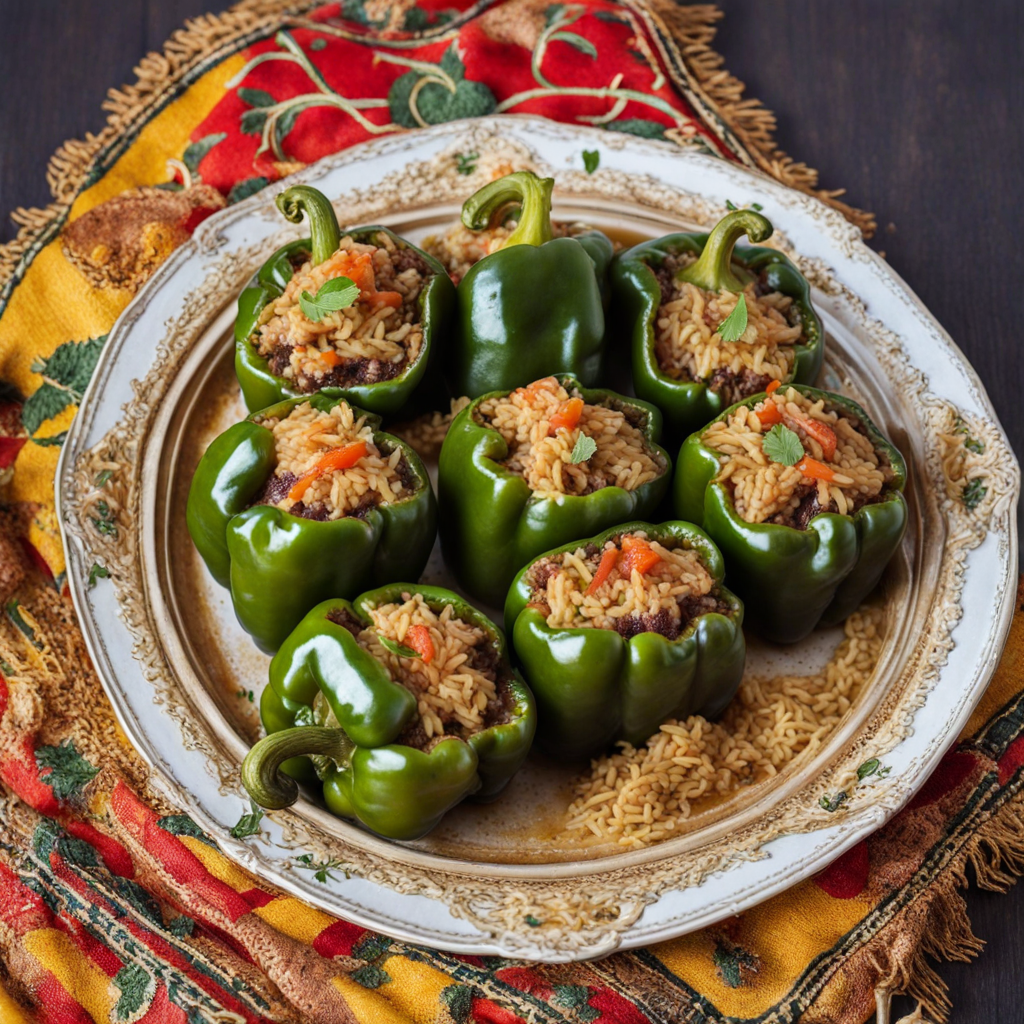Chorba Frik
Chorba Frik is a traditional Algerian soup that embodies the rich culinary heritage of North Africa. At its core, the dish features a base of lamb or chicken, simmered to perfection with an array of aromatic spices such as cumin, coriander, and cinnamon. The meat is tender and flavorful, creating a hearty foundation for this beloved dish. The addition of frik, or green durum wheat, gives the soup its unique texture and a slightly nutty flavor, as it absorbs the savory broth, making every spoonful a delightful experience. Vegetables like tomatoes, carrots, and chickpeas are often included, adding layers of taste and color, making it not only a comforting dish but also a visually appealing one. One of the standout characteristics of Chorba Frik is its robust seasoning. The spice blend, which can vary by region and family tradition, typically includes fresh herbs like parsley and cilantro, providing a burst of freshness that complements the rich flavors of the broth. A hint of lemon juice or preserved lemon is often added, offering a zesty finish that brightens the dish and enhances the overall flavor profile. This balance of spices and acidity makes Chorba Frik a multi-dimensional soup that is both warming and invigorating. Chorba Frik is often enjoyed as a starter during special occasions or family gatherings, but it can also be a comforting meal on a chilly day. Served hot, it is typically accompanied by crusty bread, perfect for dipping into the luscious broth. The communal aspect of sharing this dish with loved ones adds to its appeal, making it not just about the food itself, but about the connections and memories created around the table. For those looking to explore new flavors, Chorba Frik offers a delightful introduction to the vibrant culinary landscape of Algeria, showcasing the harmony of spices, textures, and the warmth of Algerian hospitality.
How It Became This Dish
The Rich History of شوربة فريك (Chorba Frik) in Algeria Chorba Frik, a beloved Algerian dish, encapsulates the essence of the country's culinary heritage, weaving together threads of history, culture, and tradition. This hearty soup, made with green durum wheat (frik), meat, vegetables, and an array of spices, serves not only as nourishment but also as a symbol of communal identity and resilience. To understand the significance of Chorba Frik in Algeria, one must explore its origins, its cultural relevance, and its evolution over the centuries. Origins: The Birth of a Culinary Tradition To trace the origins of Chorba Frik, we must delve into the history of Algeria, a nation with a rich tapestry of influences from Berber, Arab, Ottoman, and French cultures. The use of frik, or green wheat, dates back to ancient times. Traditionally, frik is harvested while still green and roasted, which imparts a unique smoky flavor and extends its shelf life. This method of processing grains is believed to have been practiced by early agricultural societies in the region, particularly by Berber communities, who cultivated wheat and barley thousands of years ago. The dish itself, a type of soup or stew, likely emerged as a practical meal for nomadic tribes who needed sustenance that could be prepared quickly over open flames. The incorporation of meat, usually lamb or chicken, alongside seasonal vegetables reflects the agrarian lifestyle of the population, as well as the necessity of utilizing available resources efficiently. The resulting dish was both nourishing and filling, making it ideal for families and communities. Cultural Significance: A Dish of Unity and Tradition Chorba Frik is more than just a meal; it is a cultural artifact that embodies the spirit of Algerian hospitality and communal living. Traditionally served during Ramadan, this soup is often the first dish to be consumed when breaking the fast. Its warmth and hearty ingredients provide comfort after a day of fasting, fostering a sense of togetherness among family and friends. Moreover, Chorba Frik is a staple at weddings, festivals, and other significant gatherings, symbolizing the joy of celebration and the importance of sharing food. The preparation of this dish often becomes a communal activity, with family members coming together to chop vegetables, season the meat, and stir the pot. This collective engagement reinforces familial bonds and ensures that culinary traditions are passed down through generations. In terms of cultural identity, Chorba Frik reflects Algeria’s diverse heritage. The use of spices—such as cumin, coriander, and sometimes saffron—highlights the influence of Arab culinary practices, while the method of preparing the dish resonates with Berber traditions. The interplay of these flavors and techniques showcases the harmonious blend of cultures that defines Algerian cuisine. Development Over Time: From Tradition to Modernity As Algeria navigated through various historical epochs—from the Ottoman Empire to French colonialism and independence—the preparation and consumption of Chorba Frik evolved, adapting to changing societal norms and available ingredients. During the Ottoman period, the culinary landscape of Algeria expanded significantly, with influences from Turkish cuisine. This era saw the introduction of new spices and cooking methods, which enriched traditional recipes, including Chorba Frik. The use of vegetables became more pronounced, with ingredients like carrots, potatoes, and tomatoes being incorporated into the soup, enhancing its nutritional value and flavor profile. The French colonial period brought about further changes, as new agricultural practices and ingredients were introduced. The availability of different vegetables and spices created room for experimentation in the kitchen. However, this period was also marked by struggle and resistance, and traditional dishes like Chorba Frik remained a source of comfort and identity for many Algerians. The soup became a symbol of resilience, a reminder of home, and a way to maintain cultural ties in the face of colonial pressure. With Algeria's independence in 1962, there was a revival of national pride and a concerted effort to reclaim and celebrate traditional culinary practices. Chorba Frik emerged as a symbol of this cultural renaissance. Cookbooks and culinary schools began to promote traditional Algerian dishes, ensuring that recipes were preserved and passed on to future generations. As a result, Chorba Frik became more widely recognized, both within Algeria and internationally, as a quintessential dish of Algerian cuisine. Modern Interpretations and Global Presence In contemporary times, Chorba Frik continues to evolve, reflecting the dynamic nature of Algerian society. While traditional recipes still dominate family kitchens, modern interpretations have emerged, particularly in urban areas. Chefs and home cooks alike experiment with flavors, incorporating local and international ingredients to create unique versions of the classic dish. For instance, some may add a splash of lemon juice for acidity or introduce fresh herbs for added brightness. Moreover, the global diaspora of Algerians has played a significant role in popularizing Chorba Frik beyond the borders of Algeria. Algerian communities around the world have established restaurants and cultural centers where this dish is featured prominently. Through food festivals, cooking classes, and social media, Chorba Frik has gained recognition as a representative dish of North African cuisine, celebrated for its depth of flavor and cultural significance. Conclusion: A Culinary Legacy Chorba Frik is more than just a soup; it is a testament to Algeria’s rich history and cultural diversity. It embodies the spirit of community, the importance of tradition, and the resilience of a people who have navigated through centuries of change. As it continues to be enjoyed and adapted, Chorba Frik remains a cherished part of Algerian identity—an enduring symbol of warmth, hospitality, and the vibrant tapestry of flavors that define the nation. Whether served at a family gathering, a festive occasion, or a simple weeknight dinner, Chorba Frik will always be a beloved dish that connects generations and celebrates the essence of Algerian culinary heritage.
You may like
Discover local flavors from Algeria


